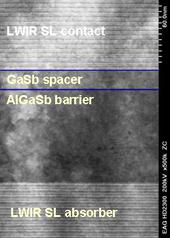Highlight
Novel detectors for imaging at IR wavelengths
Achievement/Results
NSF/IGERT fellow Arezou Khoshakhlagh and Prof. Sanjay Krishna have worked on design and growth optimization of long wave infrared regime superlattice detectors. Growth optimization has enabled them to produce high structural quality superlattice infrared detectors as evidenced by TEM images and from xray diffraction. They have also reported the first bias tunable strain layer superlattice detector using a novel nBn design. In this device, the spectral response of the sensor can be switched between two ‘colors’ on the fly by changing the bias of the detector. An image taken by our focal plane arrays using superlattice detectors is shown here. It clearly shows the thermal imprint on the person’s face and has a noise equivalent temperature difference (NETD) of 24 mK with f2 optics at 77K.
Address Goals
The work highlights an important accomplishment in improving the science and technology of imaging using infrared radiation, which is important for remote sensing, surveillance and homeland security. This work describes infrared detectors based on InAs/GaSb type II superlattices which have emerged recently as a very promising material system. Their high quantum efficiency coupled with the flexibility in the III-V technology have made them the most promising competitor for a 50 year old incumbent technology based on transitions in a low band gap semiconductor, namely, mercury cadmium telluride (MCT). Exploiting the quantum confinement in these nanoscale structures and using the same constituent materials, one can realize an “artificial semiconductor” whose bandgap can be changed from 3-30 microns (~40meV-400meV).









